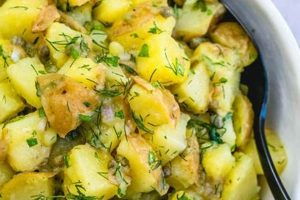A vibrant alternative to traditional mayonnaise-based versions, this dish features potatoes combined with a flavorful dressing of oil, vinegar, and seasonings. A classic example includes boiled potatoes tossed with a vinaigrette made from olive oil, red wine vinegar, Dijon mustard, herbs like parsley and chives, and perhaps a touch of shallot or garlic. Variations can incorporate other vegetables, such as celery, bell peppers, or onions.
This preparation offers a lighter, brighter flavor profile, ideal for warmer weather or as a refreshing counterpoint to rich main courses. The vinaigrette allows the natural flavors of the potatoes and other ingredients to shine. Historically, vinegar-based dressings predate the widespread use of mayonnaise, offering a practical and flavorful way to preserve and enhance vegetables. This culinary approach aligns with contemporary preferences for lighter, healthier options.
Exploration of specific ingredient choices, preparation techniques, and serving suggestions will further illuminate the versatility and appeal of this culinary staple.
Tips for a Perfect Vinaigrette Potato Salad
Achieving a well-balanced and flavorful potato salad hinges on careful attention to ingredient selection and preparation techniques.
Tip 1: Choose the Right Potatoes: Waxy potatoes, such as Yukon Gold or red-skinned varieties, hold their shape well after boiling and are ideal for this application. Avoid starchy potatoes, which tend to become mushy.
Tip 2: Perfect Potato Cooking: Cook potatoes until tender but not overcooked. Slightly undercooked potatoes will absorb the vinaigrette more effectively. Avoid overboiling, as this can result in a watery salad.
Tip 3: Dress Potatoes While Warm: Warm potatoes absorb the vinaigrette’s flavors more readily. Gently toss the potatoes with the dressing while they are still slightly warm.
Tip 4: Balance Flavors in the Vinaigrette: Achieve a harmonious balance of acidity, sweetness, and savory notes in the vinaigrette. Adjust the proportions of vinegar, oil, and seasonings to taste.
Tip 5: Incorporate Fresh Herbs: Fresh herbs add brightness and complexity to the salad. Parsley, chives, dill, and tarragon are excellent choices. Add herbs just before serving to maximize their flavor and aroma.
Tip 6: Consider Textural Variety: Add other vegetables for textural contrast. Chopped celery, bell peppers, or red onion offer appealing crunch.
Tip 7: Allow Flavors to Meld: Allow the potato salad to rest for at least 30 minutes before serving to allow the flavors to meld. This enhances the overall taste experience.
By following these tips, one can create a potato salad that is both flavorful and visually appealing. Careful attention to these details elevates this simple dish to a culinary highlight.
These insights pave the way for a deeper understanding of ingredient combinations and variations within the broader context of potato salad preparation.
1. Potato Variety
Potato variety significantly influences the final texture and flavor profile of a vinaigrette potato salad. Different potato cultivars exhibit varying starch content and moisture levels, impacting their behavior during cooking and their interaction with the vinaigrette. High-starch potatoes, such as russets, tend to disintegrate when boiled, resulting in a mushy salad. Conversely, waxy potatoes, like Yukon Gold or red-skinned varieties, hold their shape better, providing a desirable firm texture. The potato’s inherent sweetness or earthiness also contributes to the overall taste, interacting with the vinaigrette’s acidity and other flavor components. Choosing an appropriate potato variety is therefore crucial for achieving a successful vinaigrette potato salad.
For instance, a Yukon Gold potato offers a subtly sweet and buttery flavor that complements the tangy vinaigrette. Its waxy texture ensures that the potato pieces remain intact, creating a visually appealing and enjoyable salad. In contrast, a red-skinned potato provides a slightly firmer texture and earthier flavor, offering a different yet equally pleasing result when combined with the vinaigrette. Fingerling potatoes, with their unique oblong shape and delicate texture, present another compelling option. Their smaller size also means quicker cooking times, making them a convenient choice.
Selecting the appropriate potato variety is fundamental to a well-executed vinaigrette potato salad. The interplay between potato texture and flavor with the vinaigrette’s characteristics ultimately determines the dish’s success. Understanding these nuances enables informed choices and contributes to a more satisfying culinary experience. This knowledge allows for recipe adaptation based on available ingredients and desired outcomes, further highlighting the significance of potato selection in the broader context of culinary arts.
2. Vinaigrette Composition
Vinaigrette composition plays a pivotal role in defining the character of a vinaigrette potato salad. The interplay of oil, vinegar, and seasonings establishes the foundation of flavor, influencing the overall sensory experience. The type of oil contributes significantly; extra virgin olive oil imparts a robust, fruity flavor, while a lighter oil, like grapeseed, offers a more neutral backdrop. Vinegar selection provides the acidic counterpoint; red wine vinegar offers a sharp tang, while apple cider vinegar contributes a subtle sweetness. The ratio of oil to vinegar determines the vinaigrette’s consistency and its impact on the potatoes. Too much oil can result in a greasy texture, while excessive vinegar can overwhelm the other flavors.
Consider a vinaigrette crafted with extra virgin olive oil, red wine vinegar, Dijon mustard, minced shallots, and fresh thyme. The olive oil provides a rich base, while the red wine vinegar adds brightness. Dijon mustard contributes a creamy texture and tangy complexity. Shallots introduce a subtle sharpness, and fresh thyme provides an herbaceous aroma. This combination creates a layered flavor profile that complements the potatoes without overpowering them. Alternatively, a vinaigrette featuring grapeseed oil, apple cider vinegar, honey, and chopped chives offers a lighter, sweeter profile. The grapeseed oil’s neutrality allows the other ingredients to shine, while the apple cider vinegar and honey contribute a delicate sweetness. Chives provide a mild onion flavor and a vibrant green hue.
Careful consideration of vinaigrette composition is essential for achieving balance and complexity within a vinaigrette potato salad. Understanding the individual contributions of each component allows for informed choices, enabling the creation of a dressing that enhances the potatoes’ natural flavors. This understanding empowers culinary exploration and facilitates adaptation based on personal preferences and desired outcomes. The vinaigrette acts as a unifying element, transforming simple boiled potatoes into a cohesive and flavorful dish. Mastery of vinaigrette composition elevates potato salad from a simple side dish to a culinary centerpiece.
3. Ingredient Proportions
Ingredient proportions significantly influence the balance and overall success of a vinaigrette potato salad recipe. Careful measurement and adjustment of components ensure a harmonious blend of flavors and textures, preventing any single element from dominating the dish. Understanding the interplay between ingredients allows for precise control over the final product, enabling customization based on personal preferences.
- Potato to Vinaigrette Ratio:
The ratio of potatoes to vinaigrette dictates the salad’s moisture level and flavor intensity. Too much vinaigrette can result in a soggy salad, while too little can leave the potatoes dry and under-seasoned. A balanced ratio ensures that the potatoes are adequately coated and infused with flavor without becoming overwhelmed. Generally, a ratio of approximately 2:1 (potatoes to vinaigrette) provides a desirable balance.
- Oil to Vinegar Ratio within the Vinaigrette:
The balance of oil and vinegar within the vinaigrette itself is crucial for achieving the desired flavor profile and texture. Traditional vinaigrettes often employ a 3:1 ratio (oil to vinegar), providing a balanced tang without excessive acidity. However, this ratio can be adjusted based on personal preference and the specific types of oil and vinegar used. For example, a milder vinegar might allow for a higher proportion, while a more robust vinegar might require a lower proportion to maintain balance.
- Seasoning Levels:
The quantity of seasonings, such as salt, pepper, herbs, and spices, directly impacts the overall flavor complexity of the potato salad. Careful measurement prevents over-seasoning, which can mask the delicate flavors of the potatoes and other ingredients. Conversely, insufficient seasoning can result in a bland and uninspiring dish. Taste testing and incremental adjustments are essential for achieving the desired level of seasoning.
- Inclusion of Additional Ingredients:
The proportion of additional ingredients, such as chopped vegetables, herbs, or spices, contributes to the salad’s textural and flavor dimensions. These additions should complement the potatoes and vinaigrette without overpowering the core elements. For instance, a small amount of chopped red onion adds a pleasant sharpness, while a generous handful of fresh parsley provides a bright, herbaceous note. Careful consideration of proportions ensures a well-balanced and harmonious final product.
Precise ingredient proportions are essential for creating a well-executed vinaigrette potato salad. Understanding the interplay between these proportions allows for informed choices and ensures a balanced and flavorful dish. Mastery of these proportions empowers culinary creativity, enabling adaptations and personalized variations while maintaining the fundamental principles of a successful vinaigrette potato salad recipe.
4. Preparation Technique
Preparation technique significantly influences the final quality and sensory experience of a vinaigrette potato salad. Methodical approaches to key steps, from potato selection and cooking to vinaigrette preparation and ingredient incorporation, directly impact the salad’s texture, flavor, and overall appeal. Careful execution of each stage ensures a cohesive and enjoyable dish.
Potato Handling: Selecting appropriately sized potatoes and ensuring uniform cooking are crucial. Overcooked potatoes become mushy, detracting from the salad’s texture. Undercooked potatoes remain firm, hindering optimal flavor absorption from the vinaigrette. Employing proper boiling techniques, such as starting potatoes in cold, salted water and cooking until tender but not mushy, establishes a solid foundation for the salad. Cooling the potatoes adequately before adding the vinaigrette prevents premature absorption and maintains the desired texture. For example, quickly transferring boiled potatoes to an ice bath stops the cooking process and helps maintain their firmness.
Vinaigrette Emulsification: Proper emulsification of the vinaigrette ensures a stable and evenly distributed dressing. Whisking the oil and vinegar vigorously creates a temporary emulsion, preventing separation and ensuring uniform coating of the potatoes. Incorporating emulsifying agents, such as Dijon mustard or a small amount of egg yolk, enhances the vinaigrette’s stability and contributes a creamy texture. This uniform coating enhances flavor distribution and prevents pockets of excessive oil or vinegar within the salad. For instance, slowly drizzling the oil into the vinegar while whisking constantly creates a more stable emulsion compared to simply combining the ingredients and stirring.
Ingredient Incorporation: Gently folding the vinaigrette into the cooled potatoes prevents breakage and preserves the potatoes’ shape. Adding delicate ingredients, such as fresh herbs, just before serving maintains their vibrant flavor and visual appeal. This careful approach ensures that all components are evenly distributed throughout the salad, creating a harmonious blend of flavors and textures. Consider the addition of chopped hard-boiled eggs; incorporating these gently after the potatoes have been dressed with the vinaigrette prevents them from crumbling and clouding the dressing.
Precise execution of preparation techniques contributes significantly to a successful vinaigrette potato salad. Methodical attention to detail, from potato handling to vinaigrette emulsification and ingredient incorporation, ensures a balanced and enjoyable culinary experience. Understanding the cause-and-effect relationship between technique and outcome empowers informed decision-making in the kitchen, elevating the simple act of preparing potato salad to a culinary art form. This knowledge allows for adaptation and refinement of techniques, contributing to continuous improvement and a deeper appreciation for the nuances of culinary practice.
5. Flavor Balance
Flavor balance is paramount in a successful vinaigrette potato salad recipe. It represents a crucial interplay of contrasting yet complementary tastes, resulting in a harmonious and palatable dish. This balance hinges on the careful calibration of several key elements: the potato’s inherent flavor, the vinaigrette’s acidity, the richness of the oil, the pungency of seasonings, and the potential contributions of additional ingredients. Discerning the interplay of these elements distinguishes a well-executed potato salad from a mediocre one. A harmonious flavor profile elevates the dish beyond mere sustenance, transforming it into a satisfying culinary experience.
Consider the interplay between acidity and sweetness. A vinaigrette relying solely on vinegar can be overly sharp. Balancing this acidity with a touch of sweetness, perhaps from a drizzle of honey or a pinch of sugar, tempers the sharpness and creates a more rounded flavor profile. Similarly, the richness of the oil contributes to the salad’s mouthfeel and overall flavor. A robust extra virgin olive oil offers a fruity and peppery complexity, while a lighter grapeseed oil provides a more neutral backdrop, allowing other flavors to shine. The choice of oil influences the overall balance and should be considered in conjunction with the other ingredients. Seasonings, such as salt, pepper, mustard, and herbs, further contribute to the flavor matrix. Their judicious use enhances the other components without overpowering the delicate balance. For instance, a touch of Dijon mustard adds a subtle tang and complexity, while fresh dill provides a bright, herbaceous note. Adding other vegetables, like chopped celery or red onion, introduces textural and flavor nuances, further enriching the flavor profile.
Achieving flavor balance is a dynamic process requiring careful consideration of ingredient interactions and adjustments based on personal preference. Recognizing the cause-and-effect relationships between different flavor components enables informed decision-making and facilitates recipe adaptation. This understanding elevates vinaigrette potato salad preparation from a simple task to a nuanced culinary endeavor. Mastery of flavor balance unlocks the potential for creative exploration, allowing for personalized variations while maintaining the fundamental principles of a well-balanced and delicious dish. This ability to manipulate and harmonize flavors ultimately distinguishes an accomplished cook, transforming a simple potato salad into a testament to culinary expertise.
6. Serving Suggestions
Serving suggestions enhance the enjoyment of vinaigrette potato salad by considering various contextual factors, such as occasion, accompanying dishes, and desired presentation. Thoughtful consideration of these elements elevates the dining experience, transforming a simple side dish into a memorable culinary offering. Serving suggestions provide a framework for presenting the potato salad in a manner that maximizes its appeal and complements the overall meal.
- Occasion:
The occasion dictates the appropriate serving style and portion size. A casual picnic might call for a simple, family-style bowl, while a more formal dinner party might warrant individual portions plated elegantly. For a buffet-style gathering, a larger serving bowl with individual serving utensils allows guests to serve themselves. Adapting the presentation to the occasion ensures the potato salad aligns with the overall dining experience.
- Accompanying Dishes:
The flavors and textures of accompanying dishes influence the perception of the potato salad. A rich, savory main course, such as grilled steak or roasted chicken, benefits from the potato salad’s bright, acidic contrast. Conversely, lighter fare, like grilled fish or a summer salad, might pair well with a more subtly flavored potato salad. Considering the interplay of flavors ensures a balanced and harmonious meal. For example, serving the potato salad alongside grilled sausages provides a complementary textural and flavor contrast.
- Temperature:
Temperature significantly impacts the potato salad’s flavor profile and textural appeal. Serving the salad chilled enhances its refreshing qualities, particularly in warmer weather. Room temperature serving allows the subtle nuances of the vinaigrette and other ingredients to shine. Adjusting the serving temperature based on preference and ambient conditions optimizes the sensory experience. A chilled potato salad offers a refreshing counterpoint to a hot summer day, while a room-temperature salad might be preferred for a springtime picnic.
- Presentation:
Visual presentation elevates the perceived value and enjoyment of the potato salad. A simple garnish, such as a sprinkle of paprika or a scattering of fresh herbs, adds visual appeal. Serving the salad in an attractive bowl or on individual plates enhances its aesthetic appeal. Thoughtful presentation demonstrates care and attention to detail, transforming a simple dish into a more refined culinary offering. Garnishing with edible flowers adds a touch of elegance, while a rustic wooden bowl enhances the salad’s visual appeal in a casual setting.
Consideration of these serving suggestions demonstrates an understanding of the broader culinary context, transforming vinaigrette potato salad from a mere side dish into an integral component of a well-rounded meal. These considerations highlight the versatility of the dish, allowing for adaptation and customization based on specific needs and preferences. By acknowledging these elements, one elevates the dining experience, showcasing the potential of even simple dishes to contribute to a memorable and satisfying culinary occasion. The careful consideration of serving suggestions ultimately reflects a deeper appreciation for the art of dining and the transformative power of culinary presentation.
Frequently Asked Questions
This section addresses common inquiries regarding vinaigrette potato salad preparation, offering practical solutions and clarifying potential points of confusion. Clear and concise responses provide helpful guidance for achieving optimal results.
Question 1: How can one prevent the potatoes from becoming mushy?
Selecting waxy potato varieties, such as Yukon Gold or red-skinned potatoes, and avoiding overcooking are crucial. Starting potatoes in cold, salted water and cooking until just tender ensures optimal texture. An ice bath immediately after cooking stops the cooking process and helps maintain firmness.
Question 2: What can be done if the vinaigrette is too acidic?
A touch of sweetness can balance excessive acidity. A small amount of honey, maple syrup, or sugar, whisked into the vinaigrette, tempers the sharpness and creates a more rounded flavor profile. Taste testing and incremental adjustments are recommended.
Question 3: How long can vinaigrette potato salad be stored?
Properly stored in an airtight container in the refrigerator, vinaigrette potato salad typically remains fresh for up to three days. However, the quality and safety of the salad may degrade over time. Always ensure proper refrigeration and assess the salad’s quality before consumption.
Question 4: Can other vegetables be added to the salad?
Adding other vegetables enhances the salad’s textural and flavor complexity. Chopped celery, bell peppers, red onion, or green beans offer complementary flavors and textures. Incorporating these vegetables after the potatoes have been dressed with the vinaigrette prevents them from becoming overly saturated.
Question 5: What are suitable herbs for vinaigrette potato salad?
Fresh herbs elevate vinaigrette potato salad with aromatic complexity. Parsley, chives, dill, tarragon, and mint offer distinct flavor profiles. Incorporating herbs just before serving preserves their vibrancy. Experimentation with different herb combinations can yield exciting flavor variations.
Question 6: Can the vinaigrette be made in advance?
Preparing the vinaigrette in advance allows the flavors to meld, enhancing its complexity. Storing the vinaigrette in an airtight container in the refrigerator for up to a week is generally safe. However, ensure thorough emulsification before using, as separation may occur during storage.
Addressing these common inquiries empowers individuals to approach vinaigrette potato salad preparation with confidence, fostering successful outcomes and enjoyable culinary experiences.
Further exploration might delve into specific variations of vinaigrette potato salad, highlighting regional adaptations or innovative ingredient combinations. This could include a discussion of different cultural interpretations or the evolution of the dish over time. Examining these broader culinary contexts can enrich understanding and inspire creative exploration in the kitchen.
Conclusion
Exploration of vinaigrette potato salad recipes reveals a dish offering versatility and nuanced flavor profiles. Careful selection of potato variety, thoughtful vinaigrette composition, precise ingredient proportions, and meticulous preparation techniques contribute significantly to the final product. Achieving a harmonious flavor balance is paramount, requiring a keen understanding of ingredient interactions. Consideration of serving suggestions, including occasion, accompanying dishes, temperature, and presentation, further enhances the dining experience.
Culinary exploration extends beyond basic sustenance; it represents an ongoing journey of discovery. Mastery of vinaigrette potato salad preparation, while seemingly simple, provides a gateway to deeper culinary understanding. This exploration fosters creativity and adaptability in the kitchen, empowering individuals to personalize recipes and elevate everyday meals into memorable culinary experiences. The pursuit of flavor balance and technical proficiency within this specific dish translates to broader culinary skills, enriching one’s appreciation for the art of cooking.






